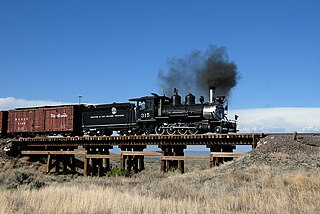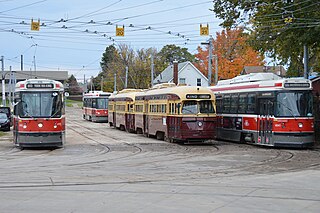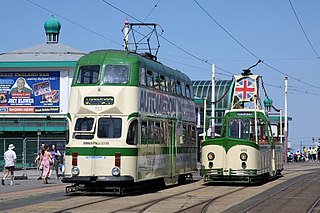
A tram is a rail vehicle that travels on tramway tracks on public urban streets; some include segments on segregated right-of-way. The tramlines or networks operated as public transport are called tramways or simply trams/streetcars. Many recently built tramways use the contemporary term light rail. The vehicles are called streetcars or trolleys in North America and trams or tramcars elsewhere. The first two terms are often used interchangeably in the United States, with trolley being the preferred term in the eastern US and streetcar in the western US. Streetcar or tramway are preferred in Canada. In parts of the United States, internally powered buses made to resemble a streetcar are often referred to as "trolleys". To avoid further confusion with trolley buses, the American Public Transportation Association (APTA) refers to them as "trolley-replica buses". In the United States, the term tram has sometimes been used for rubber-tired trackless trains, which are unrelated to other kinds of trams.

The PCC is a streetcar (tram) design that was first built in the United States in the 1930s. The design proved successful in its native country, and after World War II it was licensed for use elsewhere in the world where PCC based cars were made. The PCC car has proved to be a long-lasting icon of streetcar design, and many remain in service around the world.

Conservation and restoration of rail vehicles aims to preserve historic rail vehicles.

The Toronto streetcar system is a network of nine streetcar routes in Toronto, Ontario, Canada, operated by the Toronto Transit Commission (TTC). It is the busiest light-rail system in North America. The network is concentrated primarily in Downtown Toronto and in proximity to the city's waterfront. Much of the streetcar route network dates from the 19th century. Most of Toronto's streetcar routes operate on street trackage shared with vehicular traffic, and streetcars stop on demand at frequent stops like buses.

The Blackpool Tramway runs from Blackpool to Fleetwood on the Fylde Coast in Lancashire, England. The line dates back to 1885 and is one of the oldest electric tramways in the world. It is operated by Blackpool Transport Services (BTS) and runs for 18 km. It carried 4.8 million passengers in 2019/20.

The Urban Transportation Development Corporation Ltd. (UTDC) was a Crown corporation owned by the Government of Ontario, Canada. It was established in the 1970s as a way to enter what was then expected to be a burgeoning market in advanced light rail mass transit systems. UTDC built a respected team of engineers and project managers. It developed significant expertise in linear propulsion, steerable trucks and driverless system controls which were integrated into a transit system known as the Intermediate Capacity Transit System (ICTS). It was designed to provide service at rider levels between a traditional subway on the upper end and buses and streetcars on the lower, filling a niche aimed at suburbs that were otherwise expensive to service.

The Preston Car Company was a Canadian manufacturer of streetcars and other railway equipment, founded in 1908. The company was located in the town of Preston, Ontario. Preston sold streetcars to local transport operators including the Grand River Railway, the Toronto Railway Company and Toronto Civic Railways, and the Hamilton Street Railway. The company also sold a number of its distinctive ‘Prairie-style’ cars to operators in Alberta and Saskatchewan; one of these cars is being restored by the Saskatchewan Railway Museum. The Edmonton Radial Railway received 8 "Prairie" Prestons in 1909 and 1911 and 35 "Big" Prestons in 1913–14. Only a few Preston-built cars now remain, some of them in the collection of the Halton County Radial Railway museum. The Edmonton Radial Railway Society has in its collection "Prairie" Preston car 31 and "Big" Prestons numbers 53, 65 and 73.

The Firema T-68 was a model of light rail passenger vehicle first operated on the Manchester Metrolink network in Greater Manchester, England in 1992. It was constructed by Firema specifically as a high-floor, articulated bi-directional tram to operate solely on the Manchester Metrolink system.

The Siemens S70, its successor the S700 and European variant, the Avanto, are a series of low-floor light-rail vehicles (LRV) and streetcars manufactured by Siemens Mobility, a division of German conglomerate Siemens AG.

The Canadian Light Rail Vehicle (CLRV) and Articulated Light Rail Vehicle (ALRV) were types of streetcars used by the Toronto Transit Commission (TTC) from the late 1970s until the late 2010s. They were built following the TTC's decision to retain streetcar services in the 1970s, replacing the existing PCC streetcar fleet.

Line 6 Finch West, also known as the Finch West LRT, is a light rail line under construction in Toronto, Ontario, Canada, to be operated by the Toronto Transit Commission. The 10.3-kilometre (6.4 mi), 18-stop line is to extend from Finch West station on Line 1 Yonge–University to the North Campus of Humber College in Etobicoke. Unlike most of the Toronto streetcar system, the line will be segregated from traffic. As well, it will use transit signal priority and standard gauge rather than the broad Toronto gauge. The line is forecast to carry about 14.6 million rides a year or 40,000 a day by 2031 and will replace the 36 Finch West bus route, which is one of the three busiest bus routes in Toronto. The line is scheduled for completion in 2023, with an estimated cost of $2.5 billion.

The Flexity 2 is a family of tram or light-rail vehicle manufactured by Bombardier Transportation. It is 100% low-floor, in order to easily accommodate wheelchairs and pushchairs. The trams are bi-directional, with cabs at both ends and doors on both sides, and are articulated with five or seven sections. This family of trams debuted on the Blackpool Tramway, England.

The Flexity Outlook is the latest model of streetcar in the rolling stock of the Toronto streetcar system owned by the Toronto Transit Commission (TTC). Based on the Bombardier Flexity, they were first ordered in 2009 and were built by Bombardier Transportation in Thunder Bay and Kingston, Ontario, with specific modifications for Toronto, such as unidirectional operation and the ability to operate on the unique broad Toronto gauge.

In 2012, Blackpool Council ordered 16 Bombardier Flexity 2 trams for the Blackpool Tramway, becoming the worldwide launch customer for Bombardier Transportation's new design. The modern 100% low-floor trams replaced the Blackpool Tramway's tourist-focused and high maintenance heritage fleet, some of which have been retained with modifications for use as a supplementary fleet alongside the Flexity 2 trams and some for tourist services on the promenade. Blackpool's Flexity 2 trams are intended to be suitable for daily commuters and to provide a service competitive with other modes of transport and comply with legislation on accessibility for disabled users.
Inekon Trams, a.s. is a manufacturer of trams, or streetcars, located in the Czech Republic, and has supplied new trams to several cities in the Czech Republic and the United States. The company also carries out modernisation and repair of trams, as well as track reconstruction. It is a joint-stock company.

In 1921, the Toronto Transportation Commission (TTC) was created to integrate and operate the Toronto streetcar system. It inherited the infrastructure of two separate streetcar operators: the Toronto Railway Company (TRC) and Toronto Civic Railways (TCR). The TTC immediately embarked on a program to connect the TRC and TCR lines into one network. The TTC had to rebuild most of the track to provide a wider devilstrip so that the wider Peter Witt streetcars it was ordering could pass without sideswiping. Between 1938 and 1945, it placed five orders for air-electric PCC streetcars to replace the old, wooden streetcars of the TRC, and to address rising ridership. Between 1947 and 1951, the TTC placed three orders for all-electric PCC cars, with one order equipped with couplers for multiple-unit operation. Between 1950 and 1957, the TTC purchased PCCs from four American cities. By 1957, the TTC had more PCCs than any other city in North America. After the opening of the Bloor–Danforth subway in 1966, the TTC considered terminating all streetcar service in Toronto. However, in 1972, a citizens group led by Jane Jacobs and Steve Munro called "Streetcars for Toronto" persuaded the City to retain streetcar operation. This led to the development of the Canadian Light Rail Vehicle (CLRV) and its longer, articulated cousin, the Articulated Light Rail Vehicle (ALRV), to replace the aging PCC fleet. The Accessibility for Ontarians with Disabilities Act, 2005 (AODA) mandated that the next generation of streetcars be wheelchair-accessible. Thus, to replace the CLRVs and ALRVs, Bombardier adapted its low-floor Flexity Outlook model for the TTC to navigate the Toronto streetcar system's tight curves and single-point switches, characteristics set in the 1920s to accommodate Peter Witt streetcars.

The Alstom Flexity Freedom is a low-floor, articulated light rail vehicle developed by Bombardier Transportation for the North American market. It is marketed as part of the Bombardier Flexity family which includes other models of trams (streetcars) and light metro vehicles. They are produced in facilities in Thunder Bay and Kingston, Ontario, which once produced rolling stock under the names of Canada Car and Foundry (CC&F) and Urban Transportation Development Corporation (UTDC), respectively.

The Alstom Flexity is a family of modern trams, streetcars and light rail vehicles manufactured by Bombardier Transportation, since 2021 a division of French company Alstom. As of 2015, more than 3,500 Flexity vehicles are in operation around the world in Europe, Asia, Oceania, and North America in 100 cities among 20 countries internationally. Production of the vehicles is done at Bombardier's global production plants and by local manufacturers worldwide through technology transfer agreements.

Blackpool Heritage Trams are a mixed fleet of restored vehicles that run on the Blackpool Tramway, which runs from Blackpool to Fleetwood on the Fylde Coast in Lancashire, England. The line dates back to 1885 and is one of the oldest electric tramways in the world. It is operated by Blackpool Transport (BT) and is the last surviving first-generation tramway in the United Kingdom. Excluding museums, it is one of only a few tramways in the world to still use double-decker trams.


















